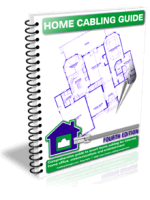| Reasonably priced cabling distribution |
| At least one time in his(her) career cabling designer is pushed by certain circumstances to use cheapest cabling design that's possible while being standard compliant. The SOHO market, educational buildings, government or military locations create good examples of environments that create a need for such a design. Here we'd like to address two of the most economically reasonable cabling distribution solutions - on-walls with J-hooks and cabling fasteners. These kinds of cable supports create an open pathway and are pretty useful if the cabling system may often experience moves, adds and changes. Usually this supporting devices are placed over suspended ceiling, but in case a building does not have one, the same rules for planning open cable supports pathways may be applied to exposed on-wall distribution. Please be advised however, that this kind of exposed distribution is not covered neither by TIA/EIA-569-A standard, that describes all the distribution pathways in commercial buildings, nor TIA-EIA-570-A that relates to residential. So you have to use this solution at your own risk. When you plan you open pathways, consider a route that's free of unavoidable obstacles such as doors, columns, plumbing tube shafts, stairways, power feeder cables and other possible electromagnetic interference sources. Try to keep this route as straight as possible. At the point of turning cable, place J-hooks or fasteners so that they will create a path to avoid sharp edges and other reasons of cable bends that are less than 4 times a cable's outside diameter. For a 4-pair CAT5(E, 6) the bend radius is about 1 inch (25 mm). The route itself should provide your with possibility to reach each give work area with a piece of cable, that is not more than 275' (90m) long. This length shell include cable slacks 7' (2 m) at the patch panel location and 1' (30 cm) at the workstation location. To pick the best location for the workstation outlet, consider all possible places where you can plug you active devices (PC, Telephone etc). You have to be able to reach these devices from an outlet that serves them, with workstation cord not more than 10' (3 m ) long. When calculating amount of J-hooks or fasteners you need, divide the combined length of all the routes by 50" - 60" (1.2 -1.5 m). This is the maximum distance between cable supports. When planning to place multiple cables on the same J-hook or fastener, expect them to hold conveniently up to 16 UTP cables. It's possible to find stronger supports, holding up to 50 cables, but for such an amount you'd be better of using another, longitudinal cable supports like wire trough, ladder cable rack or cable tray. When installing cables onto open cable supports: Do not tie cables or close fasteners so hard that the cables become dimpled or crushed. There is no data on how dimpling affects CAT5(E,6) cables performance for one sole reason - there is no cabling manufacturer at all that allows installer to fasten the cable so tight that it becomes dimpled. Actually, when you install CAT5 (CAT5E, CAT6) cable, you have to keep twisting scheme of the cable's pairs untouched. This is the way high frequency cables control an effects such as crosstalk between pairs underneath cable's jacket. So keep jacket deformation as little as possible. In an ideal situation you have to be able to move a cable from the bundle with your hand even when its already placed and secured onto cable support structure. Do not untwist pairs for the combined length of more than 1/2 " (12 mm) when terminating outlets and patch panels. Follow the manufacturer's instruction when terminating equipment. Avoid using self-crimped patch cords. Use factory-made instead. Below are some links to cable support hardware manufacturers' websites: Erico fasteners Data cable protection system by Polygon |
| Back to Designer's Tips |

